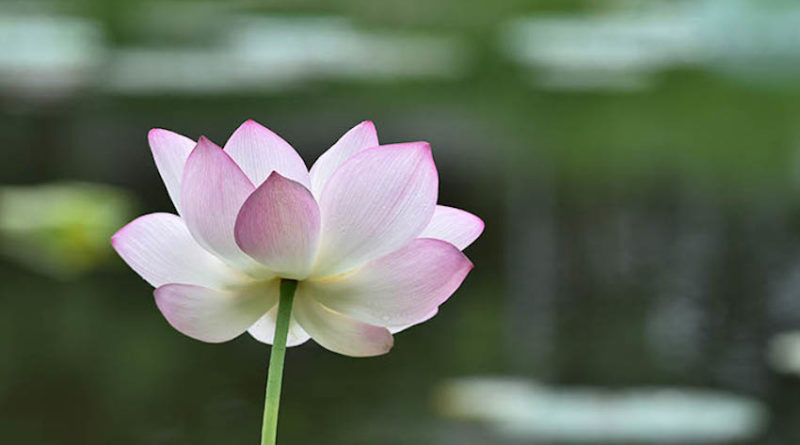WHERE WOMEN STAND
Where women stand
Phra Dhammapitaka
(Bhikkhu Payutto)
Bangkok Post – Thailand; September 22, 2001
Respected monk and scholar Phra Dhammapitaka discusses the place of women in Buddhism and the challenges they face, and what both men and women can do to make a difference. —
Bangkok Post – Thailand; Sep 22, 2001 – A STORY BY SANITSUDA EKACHAI
-ooOoo-
Calls to re-establish the Bhikkhuni-Sangha as the equal female counterpart to the Buddhist monkhood never fail to draw severe criticism from conservatives, who consider it an influence of Western feminism. But the ecclesiastical order cannot put off much longer giving proper consideration to the issue, considering its desire to win more acceptance in the course of “dhamma spread” in the West.
The arguments against the re-introduction of Bhikkhuni Sangha vary from traditional claims of women’s spiritual inadequacy because of their inherent “irrationality and sensitivity” to the more concrete, practical problems of procedure.
According to Theravada Buddhism, which governs Thailand, the re-emergence of Bhikkhuni is impossible simply because there are no existing Theravada Bhikkhuni to ordain and continue the lineage which disappeared before Buddhism was introduced to this country.
But as more educated women become interested in Buddhism, they bring with them new questions they want the clergy to answer. Among them: Where do women stand in Buddhism? Are women really spiritually inferior? How should women’s struggle towards equality in religious spheres be handled? And if the re-establishment of Bhikkhuni ordination is impossible, what is the best alternative answer to the needs of religious women who want to live an ascetic life?
Here are the authoritative views from Phra Dhammapitaka (P.A. Payutto), Thailand’s highly respected monk and Buddhist scholar, whose book, Buddha Dhamma, is considered a gem in contemporary Thai Buddhist literature.
Apart from the Bhikkhuni controversy, the monk philosopher expresses his views on feminism and its strengths and weaknesses in terms of Buddhist thinking. He also gives advice on how society should elevate women’s position in religion and how the Thai women’s rights movement should incorporate Buddhist thinking in approaching problems.
-ooOoo-
– What is the status of women in Buddhism?
This is obvious. Women, in the time of the Lord Buddha, had inferior status. Yet he established the Bhikkhuni-Sangha as a female counterpart to the male Sangha. They were equally and highly respected.
For example, we have Phra Moggallana and Phra Sariputta as Lord Buddha’s principal Bhikkhu disciples.
As for Bhikkhuni, we also have Phra Khema and Phra Uppalavanna, whose excellence was on a par with that of the Bhikkhu disciples.
There were many other highly capable and wise Bhikkhuni. So, there is no question about women’s spiritual ability to achieve Nirvana.
However, if we study the origin of Bhikkhuni, we will know that it did not come about without difficulty. And it was with great reluctance that Lord Buddha agreed to the ordination of women.
The question of women’s ordination has to be looked at on two levels, spiritually and socially. Spiritually, Lord Buddha conceded that women, too, can achieve Nirvana and it was for this reason alone that he finally ordained Bhikkhuni, although at a social cost. Socially, women’s ordination had the capability to weaken Buddhism because it made the religion, which was still young at the time, an easy target of attack.
There are also special problems springing from the nature of womanhood itself that make it more difficult and dangerous for women to live an ascetic life.
The host of complicated rules and regulations for Bhikkhunis were formulated in recognition of these difficulties. In the early phase, the Bhikkhuni roamed the forests alone in search of tranquillity, like the monks. But they were attacked. Lord Buddha then had to set rules requiring the Bhikkhunis to live in temples together with the monks.
Because of such difficulties resulting from social factors, Lord Buddha had to establish various preconditions for women who wanted to be ordained. As I see it, it was his own cautious way of making women realise the difficulty that lay ahead of them, and of ensuring the Bhikkhuni’s own institutional strength.
Historically, however, the Bhikkhunis did not last very long. This may have been caused partly by the war-related disasters which had almost entirely swept the Bhikkhu from the Indian subcontinent. In Sri Lanka, the line of Theravada Buddhism was also once severed because of wars with Portugal. To continue the lineage, they had to summon Thai Theravada monks to perform the ordination.
This is the historical reality that we have to work with. In principle, women can be ordained since they, too, can reach the ultimate truth. We once had Bhikkhuni and they proved to be highly able.
– Today we have fewer problems regarding safety and women are enjoying a better status. What do you think should be done to help women who want to devote themselves to an ordained life?
Our ancestors faced the same question. That is why we have nuns as an alternative. Nunhood was established to answer the need of religious women who want to live their lives in search of spiritual truth when there were no Theravada Bhikkhuni left to ordain them.
Nuns don white robes and shave their heads to distinguish themselves from lay people. But socially, they are not seen as the equals of monks.
Lately, however the image of the nuns has suffered. They are generally thought of as heartbroken women seeking refuge or as down-and-outs with nowhere to go, using the nun’s garb as a pretext to beg.
This is the problem that we have to solve. We have to elevate the status of nuns through educational assistance and institutional strength. Or, we can choose to set up a totally new institution like our ancestors did when they established nunhood.
In any case, even after organisational and educational improvements, nuns, in the Theravada sect, cannot be considered as equals to monks. As for those who are struggling for such status, there is still the alternative of ordination in the Mahayana sect. To be a Bhikkhuni is still possible.
– What do you think of the appropriateness of bringing up the issue of Bhikkhuni at the present time?
It’s their right to do so. The problem is that if they are ordained in the Mahayana sect, they will be treated as such. It is like being a Chinese Buddhist monk in Thailand. But they cannot use the Mahayana ordination to make them Bhikkhuni under the Theravada observance.
This is where the problem arises. As I see it, we should accept the facts realistically. If we are ordained in the Mahayana faith, so be it. We must rely on our own practices and behaviour to win respect and recognition from the public.
– It was reported there have been some movements in the West to raise this issue and that those involved have already contacted some high-ranking monks in Thailand to ask for advice.
I don’t know very much about this. I’ve heard, however, that women were also ordained in the temples in England, But they are called by a different name, not Bhikkhuni. This is one of the efforts to set up a new institution to answer women’s religious needs. It is like our own nunhood but now under several different names such as “Dasasila-Mata”, meaning the mother with 10 precepts, or another group called “Sila-carini”. Such efforts are normal. When there exists a real need on the part of women to live an ascetic life and they cannot be Bhikkhuni, new institutions are set up.
So far, this new institution has not proven very successful in Thailand, but that might not be the case in England where the social environment is different.
The question of Bhikkhuni is twofold, involving both spiritual ability and social acceptance. The lack of social acceptance and the implicit unequal status, however, does not affect women’s spiritual capability. In some places where social conditions are more favourable towards women, social acceptance of women’s ordination can be a lot easier.
– Do you personally support the ordination of women?
I agree with the setting up of an appropriate institution. I myself think that there should be some reconsideration of this issue if there exists a real need for women to lead a clerical life.
However, this is not something that can be decided in haste. It needs cautious consideration of all the positive and negative factors.
– What do you think is better in terms of social acceptance, nunhood or the setting up of a new organisation under a new name?
The improvement of nunhood is more effective in terms of social acceptance because it would be the continuation of a tradition.
The situations in Thailand and abroad are different. Over there, they can set up a new institution because the whole thing is new.
But no matter what it is called, it can be considered as one form of nunhood although they do not wear white robes. In Thailand, some groups of nuns also wear saffron robes. But this is still seen as another development of traditional nuns. This feeling of traditional continuity makes it easier to win acceptance from the more conservative sector of Thai society.
Besides, we should also consider if the setting up of a new institution apart from nunhood might lead to subsequent factionalisation and disharmony. The institutional improvement of nunhood, however, can include both the old and the new and maintain religious harmony.
– To what extent has the ecclesiastical hierarchy given assistance to Buddhist nuns?
A: The nuns have received very little official support. However, there have been efforts to raise the status of nuns through such means as the setting up of the Nun Institution of Thailand at Wat Bovorn Nives Temple. Nuns can receive an education up to the level of Parien Nine (the highest level that monks can study).
The improvement of nuns’ image and status is necessary to win public acceptance. There should be no beggar nuns left. Meanwhile, the nuns must be well educated and knowledgeable. Actually, there are many highly able nuns right now. Their knowledge in the Abhidhamma (high level dhamma) is even sought after by monks.
Self-improvement and dignified behaviour are necessary to correct the tainted image.
But to be frank, monks are also not free of criticism on grounds of inappropriate behaviour. The image of the monks is also tainted, not only that of the nun. It takes a lot of work to correct this.
Apart from self-improvement on the nuns’ part, society, too, must help, especially as regards laws. At present, the status of nuns has not yet been legally recognised.
– Do you think the new generation of women who are conscious of women’s rights will be disillusioned with Buddhism if they are denied an equal opportunity to enter religious life?
There is no need to feel that way. The problem is not that difficult. We only have to look at where the problem lies and solve it. In this case, it comes from society. Since the problem arises from the lack of social acceptance and from unfavourable social conditions _ we only have to find social means to correct it. Women’s spiritual capacity is not in question.
– How would you analyse the problem of male/female relationships and their consequent conflicts?
The problem is threefold. Firstly, biological difference. Secondly, social values and conditions. And thirdly, the spiritual and mental aspect, including one’s capabilities.
There is no question on the third point. For women, too, can reach ultimate Truth and become “Phra Arahant” (enlightened ones). But even Phra Arahant cannot remove themselves from the world. That’s why we have to take into account what determines our place in society.
Nature and social conditions are correlated. Women’s biological nature has placed them socially at a disadvantage. And because of this biological predestination, it is more difficult for women than men to live a life that is free and independent from society.
– According to feminist thinking, differences between women and men mainly come from culture and socialisation.
But the truth of biological difference is indisputable. Women are childbearers. And women are immediately in a different social position for this reason alone. Women have to be constantly cautious whenever and wherever they go because they are easy targets of attack. Even today, when society has made much progress in other difficult areas, this problem of women’s safety has not been solved.
– There are arguments that given the dynamic social changes and technological advances of recent years, the sharp division of sex roles is already blurred, and because of this change women’s roles, including those in religion, should be reconsidered.
I have read articles about the women’s rights movement. I think it is going too far if men and women are busy fighting over their own self-interests and becoming enemies instead of cooperating for the common good of their children.
– How is the problem of women’s rights seen from the point of view of Buddhism?
It is simply seen from reality, from what is. For example, we have to look at women’s actual social and biological conditions realistically. However, I think society has improved so much that the use of physical force to maintain power is decreasing, which effects the relationship of men and women.
Changes are needed to fit the new social reality. If society is less violent, women’s status will be better and make their ascetic life easier. All is inter-related.
– Do you think that campaigns to correct social injustices, especially the women’s rights movement, are still hampered by emotional considerations?
It is still a problem. But it is also understandable. It is natural that men, or any other human group, will hold on to their privileges and will not want to see their interests compromised. But among them, there must be some with good intentions who want to cooperate in bringing about change.
Also, the end should be consistent with the means. If we are pursuing a virtuous goal, the means must also be virtuous. Anger and hatred only evoke strong reactions that will only make our efforts to change things more difficult. More often than not, we still rely on dominance and aggression to solve problems. This ironically shows that humans have not made much progress in this sense.
– Does that mean the use of united force and bargaining are still necessary then, given the selfish nature of human beings?
Our means should help develop society at the same time, that is, to help create a society where problems are solved through wisdom and peaceful means.
But this is often easier said than done. From what I’ve observed, even the women’s rights movement is focusing on the conflict of interests between men and women. It has become a battle. This is but one such form of struggle. The enlightened path is to use reason and rationality. We need to clarify and point out where the inequality lies or what injustices should be corrected, then clarify the negative social consequences brought about by women’s inequality.
– Which Buddhist values do you think can be used in staging consciousness-raising campaigns on women’s human rights?
All. But the first and foremost is not to let ourselves be dominated by emotions. Apart from rationality, the movement should be based on compassion beyond our own interests for the good of society. The women’s rights movement should also integrate compassion for men by encouraging people to help one another to have a better life together.
The use of force to bargain may still be a necessary strategy given the awareness that human beings are still not that developed. But it will be better if we use it as sparingly as possible so that we may help raise the standards of our society.
To improve the status of women in religious life can be done through many peaceful means such as education, image improvement, and endorsing their legal status.
– Won’t the establishment of Bhikkhuni-Sangha help strengthen and spread the Lord Buddha’s teachings?
A: Yes. Even today when women cannot be ordained, they are already strong supporters of Buddhism. There are several women who are very knowledgeable in the Abhidhamna.
It must be stressed, however, that we should not let efforts to improve the status of women develop into a conflict of interests which will trigger clashes and the use of emotions. The best way is to aim for higher good out of compassion for society, especially compassion for women, which also means a better life for men and women together.
– What is Your Reverend’s opinion on the changing of men’s attitudes to keep up with the changing role of women?
Men must admit that the social situation now is no longer the same, and that it calls for some adaptation on their part.
In the old days, physical protection for women was important, and that fact partly accounts for male dominance in society.
But society is changing vastly. There is more social safety, and reason is more important than force. The development of women’s status has to go hand in hand with the development toward a non-violent society. If not, women and men will find themselves being enemies instead of helping one another toward a better life. Parents should think about what they must do for the good of their own children, and not be obsessed with being equals.
– There are some arguments that women’s sacrifices have been so long emphasised that a woman’s assertion of her rights is seen as selfishness.
We have to look carefully at how culture permutates and advances. Culture is partly determined by the natural biological differences between men and women. Culture was not created only to please one segment of people in society. However, the stronger use their physical advantages to exploit the weak, which leads to an unequal relationship.
To solve the problem, we should not deny biological reality. But a stronger group should not take advantage of a weaker. This is the key, the rearrangement of relations.
In order to understand the problem of women’s rights, we should take into account the three facets of the problem, biological, social and spiritual. They cannot be isolated from one another. The problem can be solved through compassion. Men, given their better position, should even be more compassionate and try to give women more opportunities. This is because, in terms of dhamma, when we admit that men and women could achieve the ultimate truth spiritually, a good society is, therefore, a society which gives opportunities for everyone to reach this potential.
– In your opinion, what is the ideal relationship between men and women?
It must be based on mutual compassion. Men should think what can be done to help women further their personal growth and fulfil their potential.
– What do you think about women’s equality?
Equality should not be the end in itself. It should only be seen as a means or a factor to help men and women to live a life in which they are both able to achieve their spiritual potential and to reach the ultimate truth together.







